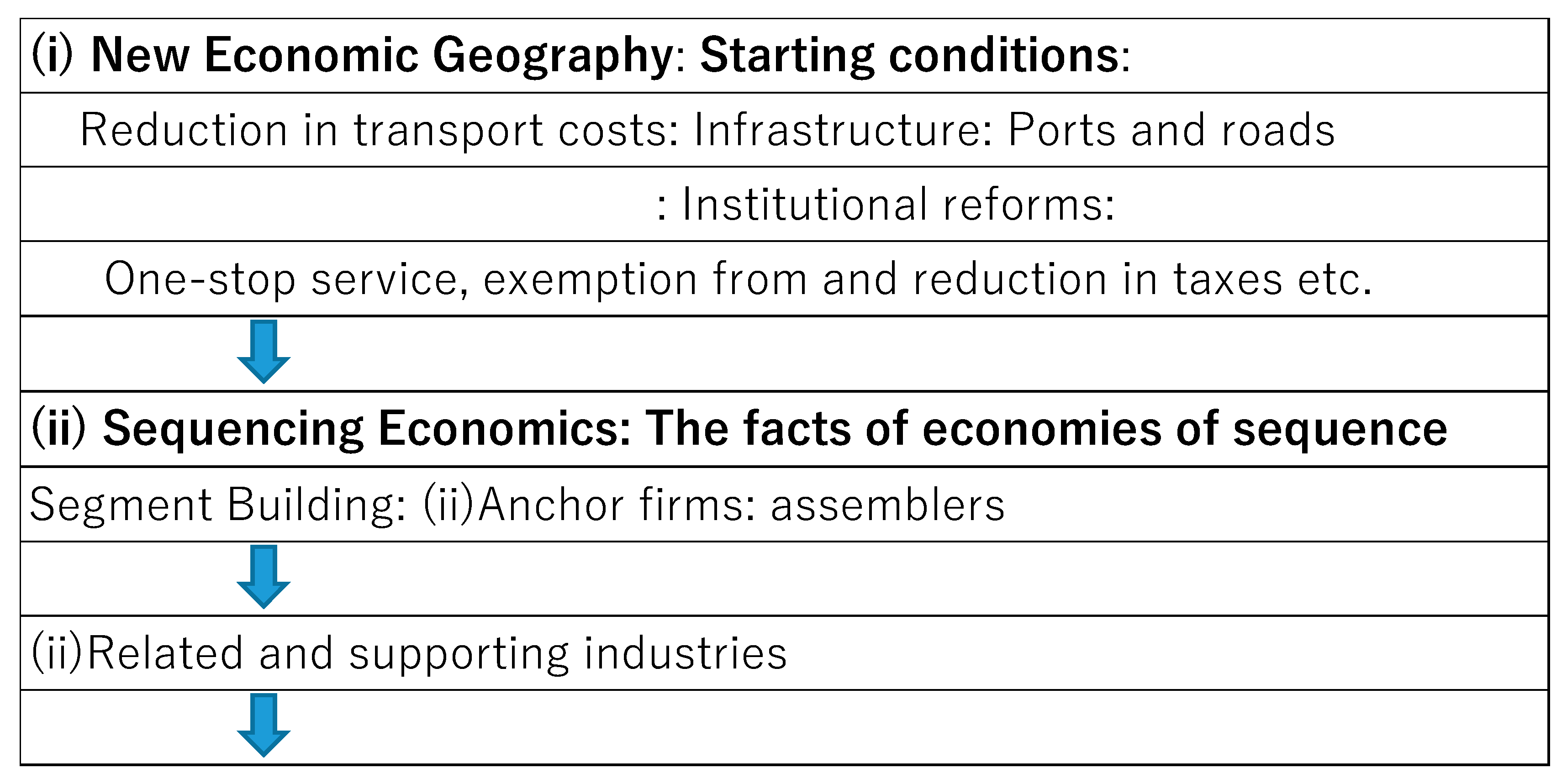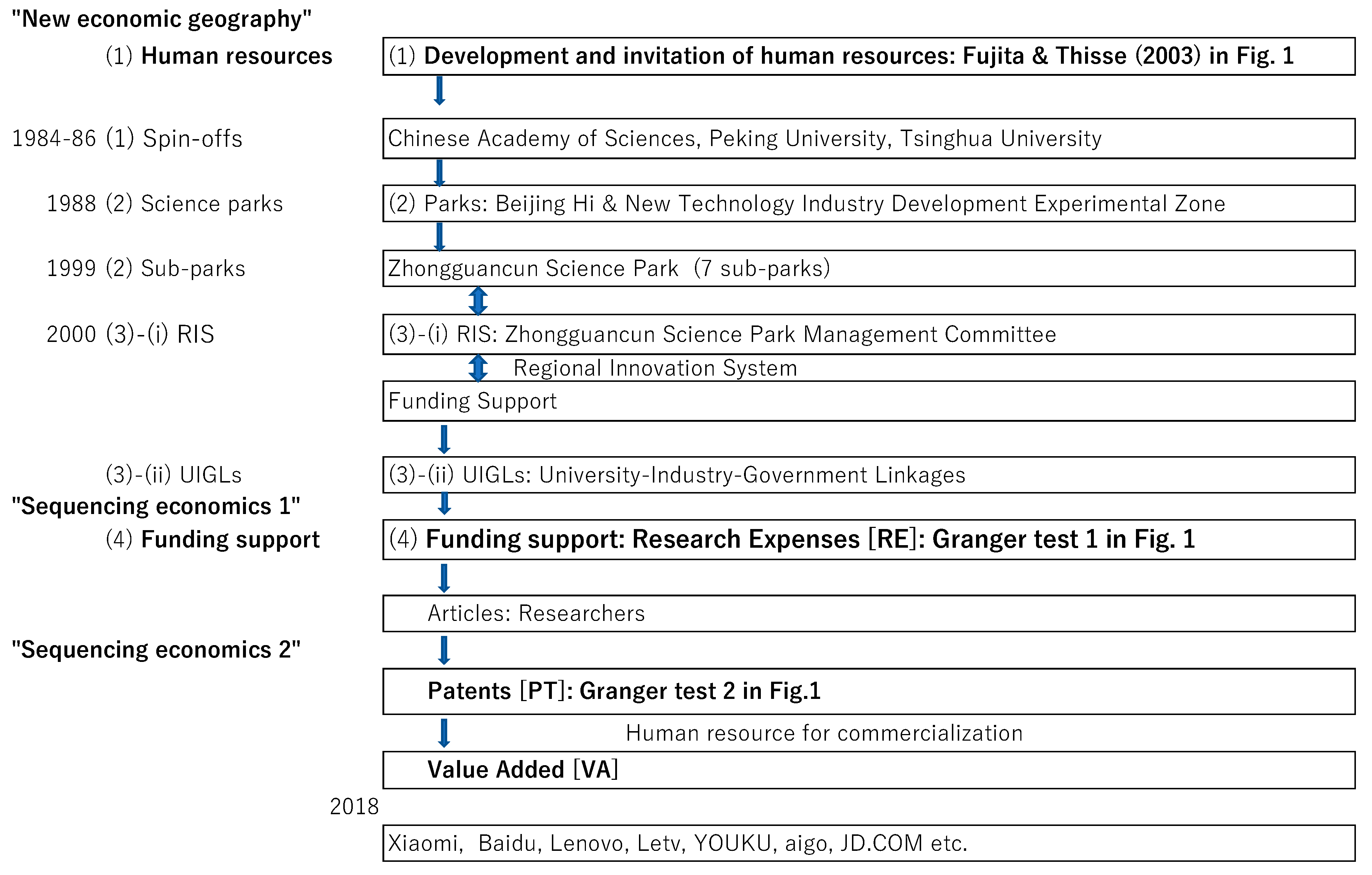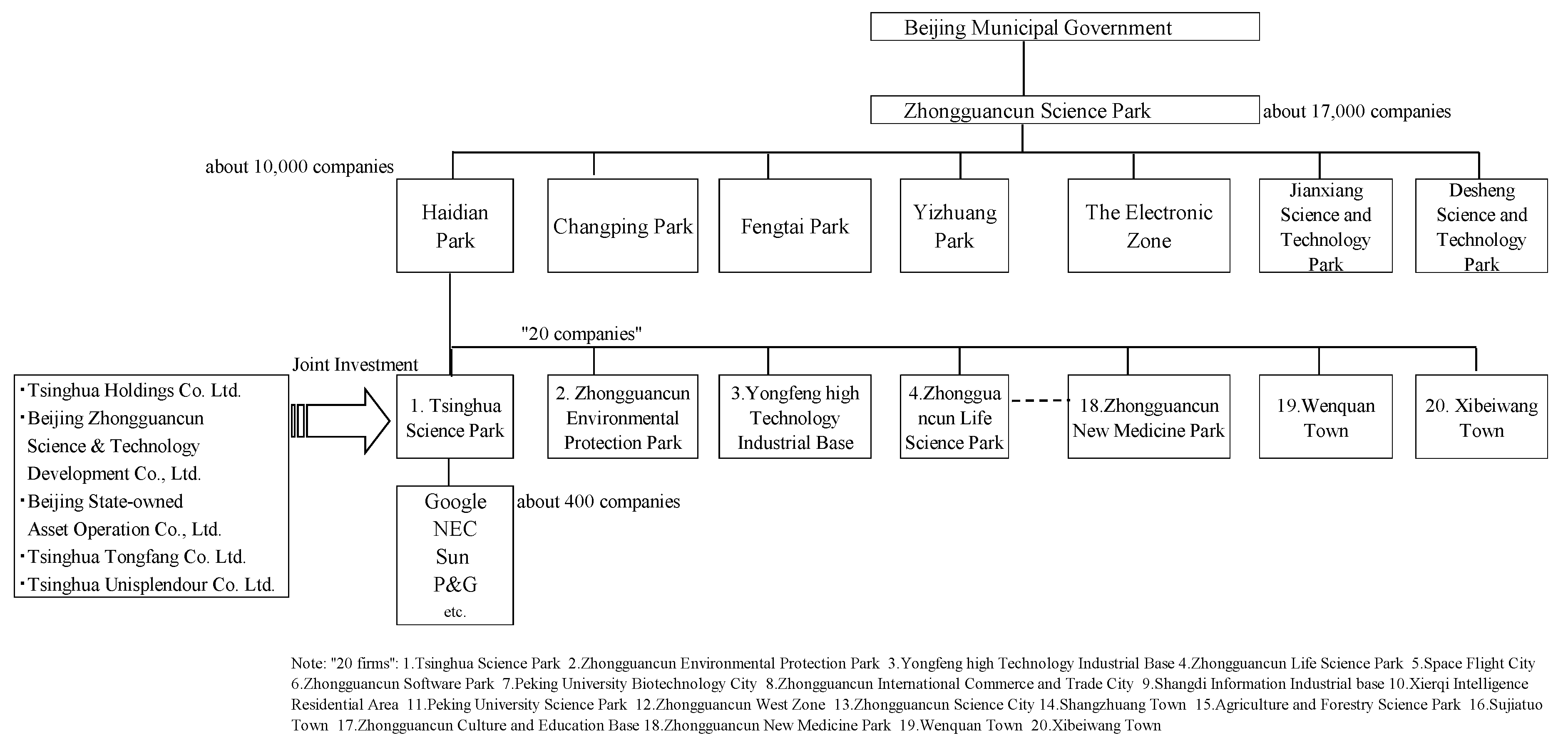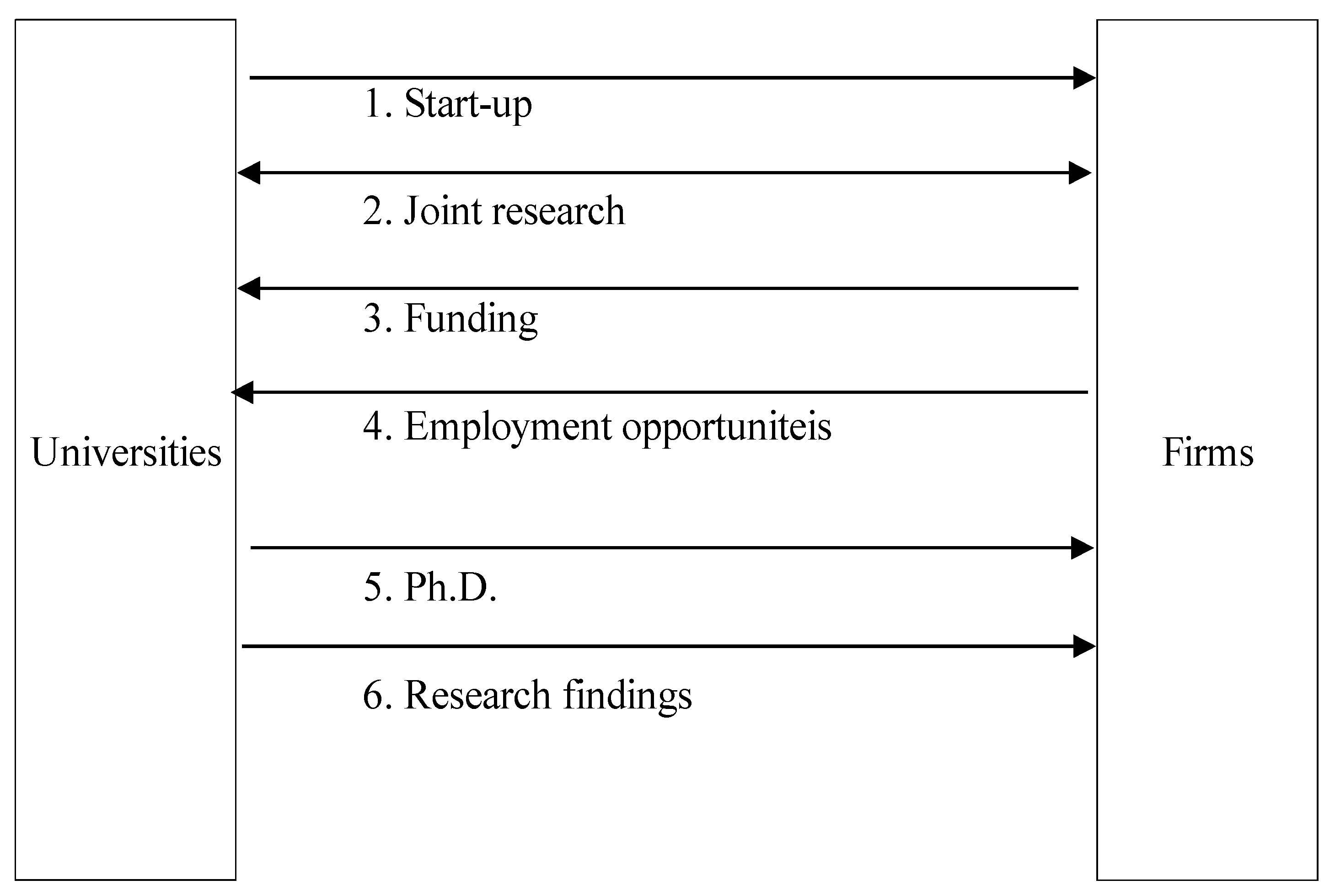‘Sequencing Economics’ on the ICT Industry Agglomeration for Economic Integration
Abstract
1. Introduction
2. Sequencing Economics in the ICT Industry
2.1. The First Stage (Agglomeration) and the Second Stage (Innovation)
2.2. Economies of Sequence
3. The Key Segments of an ICT Agglomeration at Zhongguancun Science Park (ZSP)
3.1. The Segment of Human Resources
3.1.1. Human Resource Development
3.1.2. The Invitation of Human Resource: Beijing Residency Permits
3.2. The Segment of Science Parks and Sub-Parks
Zhongguancun Science Park (ZSP)
3.3. The Segments of Institutions
3.3.1. The Segment of Regional Innovation System (RIS)
3.3.2. The Segment of University–Industry–Government
3.4. The Segment of Funding Support
3.5. The Results of the Agglomeration Policy Implemented by Beijing City
4. Granger Causality Tests on the ICT and Computer Industries
5. Summary and Conclusions
Funding
Acknowledgments
Conflicts of Interest
Appendix A. The Model of Fujita and Thisse
M1 = (E1 − φE2) M/(1 − φ) E*, M2 = (E2 − φE1) M/(1 − φ) E*,
d[E1 (λ)/E2(λ)]/dλ > 0, λ ∈ (0,1).
Appendix B. Data Sources of Table 6
- (1)
- [PT]: Patents: World Intellectual Property Organization. 2020. Available online:
- (2)
- [VA]: Added value: National Science Foundation. 2020. Available online: https://www.nsf.gov/statistics/
- (3)
- [AC]: Number of Published Science and Engineering Articles: National Science Foundation. 2020. Available online:
- (4)
- [RE]: Research expenses: OECD Science, Technology and Innovation Outlook 2018, OECD Publishing, Paris. Available online:(accessed on 2 May 2019)
References
- Brimble, Peter, and Richard Doner. 2007. University-Industry Linkages and Economic Development: The Case of Thailand. World Development 35: 1056–74. [Google Scholar]
- Chen, Weiliang, Xinjian Huang, Yanhong Liu, Xin Luan, and Yan Song. 2019. The Impact of High-tech Industry Agglomeration on Green Economy Efficiency. Sustainability 11: 5189. [Google Scholar] [CrossRef]
- Fujita, Masahisa. 2003. Significance and issues of Japanese industrial agglomeration policy from the point of spatial economics. In Japan’s Industrial Cluster Strategy. Edited by Akira Yamazaki. Tokyo: Yuhikaku, pp. 211–61. [Google Scholar]
- Fujita, Masahisa, and Jacques-Francois Thisse. 2003. Does Geographical Agglomeration Foster Economic Growth? And Who Gains and Losses from It? Japanese Economic Review 54: 121–45. [Google Scholar] [CrossRef]
- Fujita, Masahisa, Paul Krugman, and Anthony J. Venables. 1999. The Spatial Economy. Cambridge: MIT Press. [Google Scholar]
- Han, Ji, Gang Liu, Daniele L. Rosa, and Xia Li. 2019a. Special Issue Building Regional Sustainability in Urban Agglomeration. Sustainability (ISSN2071-1050). Available online: https://www.mdpi.com/journal/sustainability/special_issues/Urban_Agglomeration (accessed on 21 March 2020).
- Han, Wei, Ying Zhang, Jianming Cai, and Enpu Ma. 2019b. Does Industrial Agglomeration Lead to the Improvement of Land Use Efficiency in China? Sustainability 11: 986. [Google Scholar] [CrossRef]
- Hershberg, Eric, Kaoru Nabeshima, and Shahid Yusuf. 2007. Opening the Ivory Tower to Business: University-Industry Linkages and the Development of Knowledge-Intensive Clusters in Asian Cities. World Development 35: 931–40. [Google Scholar] [CrossRef]
- Hirose, Kyoko. 2008. Migration and Agglomeration with Knowledge Spillovers. Japanese Economic Review 59: 459–97. [Google Scholar] [CrossRef]
- Krugman, Paul. 1991. Increasing Returns and Economic Geography. Journal of Political Economy 99: 483–99. [Google Scholar] [CrossRef]
- Kuchiki, Akifumi. 2006. Theoretical Models Based on a Flowchart Approach to Industrial Cluster Policy. In Regional Integration in East Asia from the Viewpoint of Spatial Economics. JRP Series No.138. Edited by Fujita M. and A. Kuchiki. Chiba: IDE-JETRO, pp. 73–96. [Google Scholar]
- Kuchiki, Akifumi. 2007. Clusters and Innovation: Beijing’s Hi-technology Industry Cluster and Guangzhou’s Automobile Industry Cluster, Institute of Developing Economies, Japan External Trade Organization. In IDE-JETRO Discussion Paper. Chiba: IDE-JETRO, 89 vols. [Google Scholar]
- Kuchiki, Akifumi. 2019. The Existence of Economies of Sequence: A Theory of Architecture in Building an Industry Agglomeration. Regional Science Policy and Practice 11: 597–612. [Google Scholar] [CrossRef]
- Kuchiki, Akifumi. 2020a. A Flowchart Approach to Industrial Hubs and Industrialization. In The Oxford Handbook of Industrial Hubs and Economic Development. Edited by Oqubay A. and J. Lin. Oxford: Oxford University Press, Chapter 19, pp. 345–77. [Google Scholar]
- Kuchiki, Akifumi. 2020b. On ‘Economies of Sequence’ in the Architectural Theory of Agglomeration: A Case of the Kyoto Tourism Industry. Economies 8: 15. [Google Scholar] [CrossRef]
- Kuchiki, Akifumi, Tetsuo Mizobe, and Toshitaka Gokan, eds. 2017. A Multi-Industrial Linkages Approach to Cluster Building in East Asia. New York: Palgrave Macmillan. [Google Scholar]
- Martin, Philippe, and Gianmarco I. P. Ottaviano. 2001. Growth and Agglomeration. International Economic Review 42: 947–68. [Google Scholar] [CrossRef]
- Monti, Antonello, and Ponci Ferdinanda. 2017 Special Issue ICT for Energy. Energies. Available online: https://www.mdpi.com/journal/energies/special_issues/ICT_energy (accessed on 2 December 2020).
- Porter, Mickael. 1990. The Competitive Advantage of Nations. Harvard Business Review 68: 73–93. [Google Scholar]
- Sato, Yasuhiro, Takatoshi Tabuchi, and Kazuhiro Yamamoto. 2011. The Spatial Economy. Tokyo: Yuhikaku. (In Japanese) [Google Scholar]
| 1 | Administrative Committee of Zhongguancun Science Park. 2018. 2 December. Available online: http://www.chinadaily.com.cn/m/beijing/zhongguancun/2018-02/12/content_35696638.htm (accessed on 17 February 2019). |
| 2 | Same as that of Note 1 |
| 3 | China Intellectual Property. 2019. Available online: http://www.chinaipmagazine.com/en/journal-show.asp?id=1038 (accessed on 22 May 2019.) |
| 4 | South China Morning Post. 2018. Mandy Zuo, 5 March. Available online: (accessed on 30 March 2018). |
| 5 | Du Yan. 2019. Chinanews.com, Beijing, 11 September. Available online: http://english.iccie.cn/web/static/articles/catalog_ff80808133067bbf01330fc4f7050016/article_ff8080815becfb08015e78db27ec5107/ff8080815becfb08015e78db27ec5107.html (accessed on 11 September 2019). |
| 6 | Wang Hongyan. 2018. Administrative Committee of Zhongguancun Science Park, Tokyo Office. Available online: https://www.vipo.or.jp/u/180308_2.pdf (accessed on 11 December 2018). |





| Theory | (i) Location | (ii) Architecture | (iii) Geographical Management |
| Fujita et al. (1999) | Kuchiki (2019) | Porter (1990) | |
| Model | (i) New Economic Geography | (ii) Sequencing Economics | (iii) Diamond Model |
| Characteristics | To show how a two-region can become a core-periphery pattern | Sequential processes in efficiently building the segments of an agglomeration | Finding the factors of “competitive advantages” of a region |
| Key factors | The Dixit–Stiglitz model, economies of scale, and transport costs | Integration of ‘economies of sequence’ between two segments | 1. Demand conditions; 2. Factor conditions; 3. Firm strategy, structure, rivalry; 4. Related and supporting industries |
| Segment | |
|---|---|
| Human resources | (1) Development and invitation |
| Persons in charge of commercialization (Granger test) | |
| Infrastructure | (2) Parks, sub-parks |
| Railway | |
| Airport | |
| Port | |
| Communication | |
| Water | |
| Electricity | |
| Roads | |
| Institutions | (3) RIS, UIGLs |
| (4) Funding support | |
| Funds (Granger test) | |
| Laws and regulations | |
| Living conditions | Housing and entertainment |
| Hospitals and schools | |
| The environment | |
| Research Institutes/Universities | Name of Enterprise | Notes |
|---|---|---|
| Institute of Computing Technology, Chinese Academy of Sciences | Lenovo Group Ltd. | Development, manufacture and sales of computer products |
| Software Research Institute of Chinese Academy of Sciences | Red Flag Software Co., Ltd. | Ministry of Information Industry invested a hundred million yuan in 2001 |
| Chinese Academy of Science | China Sciences Group (Holdings) Corporation | Zhong Ke San Huan, Zhong Ke Hope Software, Shanghai China Science, Dayang and CSCA Technology, etc. |
| China Daheng Group Inc. | Optical components, China’s Top 100 Electronics Enterprises | |
| Peking University | Peking University Founder Group Corp. | Computer and multimedia products |
| Beida Jade Bird Group | Software production, mainly software development, system integration, and computer security | |
| Tsinghua University | Tsinghua Tongfang Co. Ltd. | Computer products |
| Tsinghua Unisplendour Co. Ltd. | Environmental protection industry |
| (1) Human Resource |
| Persons studying abroad or technical and managerial talents from other provinces or cities: Beijing residency permits. |
| Their children: compulsory education. |
| Newly graduated students from colleges and universities: their entering Beijing. |
| (2) Funding |
| New and innovative technology, risk investment, and guarantee funds. |
| Risk investment institutions: the form of limited liability of partnerships. |
| Beijing Municipality subsidies: a limit of ten million yuan. |
| Subsidies up to 50% of the interest on loans. |
| Small loans to enterprises established by students returning from overseas: a limit of one million yuan. |
| Incubator Fund established within the past three years: a limit of three million yuan. |
| Special funds: senior managerial personnel and technical personnel in software enterprises and IC enterprises. |
| Integrated Circuit Design Enterprise Loans. |
| Park | District | Surface Area (km2) | Number of Companies | Research Institutes/Universities | Researchers | |
|---|---|---|---|---|---|---|
| 1 | Haidian Park | Haidian District | 217 | Over 10,000 | Research institutes: 232 Universities: 73 | Researchers: 378,000 University students: 300,000 |
| 2 | Changping Park | Changping District | 5 | Over 1300 | Research institutes: 114 Universities: 14 | Researchers: 15,000 |
| 3 | Fengtai Park | Fengtai District | 5 | Over 2700 | Research institutes: 60 | Researchers: 70,000 |
| 4 | Yizhuang Park | Inside the Beijing Economic-Technological Development Area | 7.5 | Over 1000 | ― | ― |
| 5 | The Electronic Zone | Jiuxianqiao, Chaoyang District | 10.5 | Over 440 | Electronic research institute: 4Electronic universities: 5 | ― |
| 6 | Desheng Science and Technology Park | Xicheng District | 6 | 145 | CAS Institutes: 12 | CAS academic members: 44 CAE academic members: 5 TWAS academic members: 5 |
| 7 | Jianxiang Science and Technology Park | Chaoyang District | 4.2 | ― | Research institutes: 6Universities: 8 | ― |
| Industry | Research Expenses [RE] | # of Articles [AC] | # of Patents [PT] | Value Added [VA] | |||
|---|---|---|---|---|---|---|---|
| Italy | ICT | [RE] ⍈ | ⍈ | ⍈ | (1) 0.1033 [RE] | ||
| Computer | [PT]⍈ | (2) 0.09378 [PT]) | |||||
| Korea | ICT | [RE] ⍈ | ⍈ | ⍈ | (1) 0.09666 [RE] | (4) 0.0177 [PT] | |
| Computer | |||||||
| Germany | ICT | [RE] ⍈ | ⍈ | ⍈ | (4) 0.06848 [RE] | (1 )0.04618 [PT] | |
| Computer | |||||||
| USA | ICT | ||||||
| Computer | [RE] ⍈ | ⍈ | ⍈ | (3) 0.0001304 [RE] | ⍈ (1)0.02972 [AC] | (2) 0.1167 [PT] | |
| Japan | ICT | ||||||
| Computer | ⍈ (2)0.03777 [AC] | (2) 0.001552 [PT] | |||||
| China | ICT | ||||||
| Computer | [RE] ⍈ | ⍈ | ⍈ | (3) 0.000001894 [RE] | [PT]⍈ | (3) 0.1017 [PT] | |
| UK | ICT | [PT]⍈ | (4) 0.02669 [PT] | ||||
| Computer | [PT]⍈ | (4) 0.06605 [PT] | |||||
| France | ICT | [PT]⍈ | (3) 0.004153 [PT] | ||||
| Computer | |||||||
| India | ICT | [PT]⍈ | (3) 0.06326 [PT] | ||||
| Computer | |||||||
Publisher’s Note: MDPI stays neutral with regard to jurisdictional claims in published maps and institutional affiliations. |
© 2021 by the author. Licensee MDPI, Basel, Switzerland. This article is an open access article distributed under the terms and conditions of the Creative Commons Attribution (CC BY) license (http://creativecommons.org/licenses/by/4.0/).
Share and Cite
Kuchiki, A. ‘Sequencing Economics’ on the ICT Industry Agglomeration for Economic Integration. Economies 2021, 9, 2. https://doi.org/10.3390/economies9010002
Kuchiki A. ‘Sequencing Economics’ on the ICT Industry Agglomeration for Economic Integration. Economies. 2021; 9(1):2. https://doi.org/10.3390/economies9010002
Chicago/Turabian StyleKuchiki, Akifumi. 2021. "‘Sequencing Economics’ on the ICT Industry Agglomeration for Economic Integration" Economies 9, no. 1: 2. https://doi.org/10.3390/economies9010002
APA StyleKuchiki, A. (2021). ‘Sequencing Economics’ on the ICT Industry Agglomeration for Economic Integration. Economies, 9(1), 2. https://doi.org/10.3390/economies9010002





